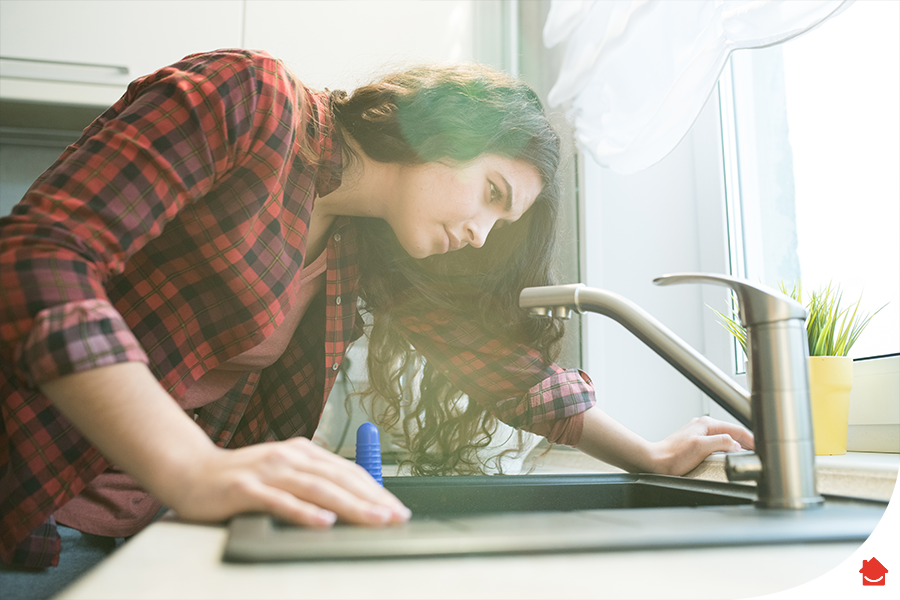Plumbing advice
How to unblock your kitchen sink
05 Feb 2021 • 9 minutes


A blocked kitchen sink is one of the most common household problems going, mostly due to the fact that we happily let all kinds of food debris, coffee grounds and soap residue slide unceremoniously down the drain. The good news is, blocked drains are one of the easiest home fixes to do for any DIY-er, from beginner to expert!
When you find your kitchen drain completely blocked up, you may be inclined to run to the shops and buy up all the harsh chemical cleaners to cut through the block. But hold up! Before you buy a super-harsh chemical cleaner, know that this is not the only option. In fact, it may end up causing long-term damage to your sink. Plus, backsplash from stubborn blockages can seriously harm your skin and eyes – and the stuff is extremely harmful to our environment. This guide will give you a range of options on how to unblock a sink using common household products, and advice on how to avoid a blockage in future. (As always, if the methods below don’t work and you, therefore, suspect a more serious issue, call in the HomeServe pros.)
Not all drains are created equal, so if you’re having issues with your shower or bathroom drains, then read our handy how-to guide with full step-by-step instructions on how to unblock a bath or shower.
Here are five methods to unblock your blocked kitchen sink:
If you’ve dealt with drain blockages before and are an avid DIY-er, you’ll know boiling water is the easiest and least expensive solution of all, which makes it the best one to try first. Boiling water may be all your pipes need to loosen a blockage made up of grease, soap residue and food debris.
Top tip: If you have plastic pipes instead of metal ones, switch off your kettle early and use only partially boiled water to avoid damage to your pipes.
You may need to repeat the process several times to move the clog, but this often works on many types of blockages.
If you find your blockage is too much of a monster for this simple method, move on to the next method.
A step up from boiling water, this natural method can be very effective as an alternative to chemicals. This magic mixture includes ingredients you probably already have in your home. Watch the video and/or follow the steps below to learn how to unblock your kitchen sink with baking soda or effervescent tablet and vinegar.
This is another combination that can work to unblock your kitchen sink:
If it seems like you’re making progress on the blockage after a couple of tries, you’ll get there with this method. Repeat until fixed. If your kitchen sink is still backed up, move on to the next method.
It’s time to get physical. Regretting all those times you washed food remnants down the sink yet? Let’s take the plunge. Make sure you use a flat-bottomed plunger so you can get a really good seal on your plughole.
The sinks U-bend is the curved bit of the drainpipe underneath your sink. A P-trap is your U-bend plus another bit of piping that altogether resembles a ‘P’ shape. Sometimes food debris collects in the U-bend and turns into gunk, causing your sink to drain slowly or not at all. Here’s how to check and clear it:
So you’ve got a horribly stubborn blockage, eh? It’s time to bring out the big guns. Sometimes called an auger or a plumber’s snake, a pipe snake is a thin, flexible cable that can reach into the drain to unclog a blockage that may be stuck further down the system. If you don’t have one, you can fashion a wire coat hanger into a homemade plumber’s snake – unwind it so it’s one long wire but keep the hooked end and make it small enough to enter the pipe.
Congratulations!
Now you’re a battle-scarred sink unblocker, you may think twice about pouring those daily coffee grounds and bits of food down the sink. It’s actually very easy to make sure your kitchen sink is draining correctly and avoid future blockages.
Find out How to get rid of kitchen smells and keep your sink smelling fresh and running smoothly.
If you’ve tried the methods listed in this article and are still having trouble with your kitchen sink not draining, it may be time for a more thorough inspection by a professional. Contact HomeServe and we can arrange for a qualified local plumber to fix and unblock your kitchen sink.

Our help & advice articles cover Plumbing, Home heating, Electrical, Energy-saving and Home maintenance.